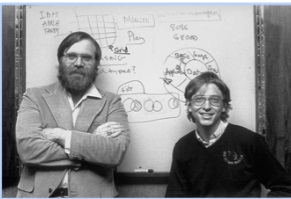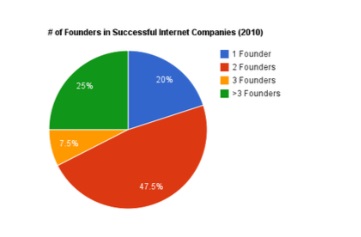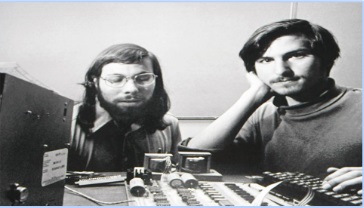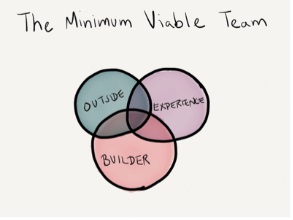Day 6. Team. How to organize team work. Rituals. Shares. MVT+MVP+MVA. N22
How to Copy Businesses and Stay Original
Team is the most crucial factor. Assuming that in the formula “market, product, team,” the market and product are considered proven. We should believe, looking at ourselves or the project founders, that they will build a new leader in a market of at least a billion dollars in scale.
Market and team are the two main filters. Product and others have lower priority.
- If a strong team enters a small market, it conquers the market.
- If a weak team enters a large market, it conquers the market.
- If a strong team enters a large market, a miracle happens.
Popular tools and experience working with a team in a startup.
Most successful projects at the start usually have 2-5 founders, often two (Apple, Microsoft, Yandex, and many others). Most projects were founded by 2-3 founders, and there are projects that were founded by a single person (Facebook). The most common approach is “author + producer.” Any project, any product entering the market, must succeed in two things:
- Succeed in sales channels.
- It must be a priority compared to competitors when reaching the audience through various means.
Point 2. Having reached the audience, it must be a priority compared to competitors.
- Example: We go to a store. We see products that are not the best. These are the ones that first made it to the shelf. It was the work of salespersons to get their product on the shelf.
- When a person sees 20 similar products on the shelf, something must be done to make them choose your product among many others.
These two biggest tasks define roles. One for the product, the other for sales channels. So, a producer (Hustler) focuses on marketing. They already have experience in selling similar products, their customer base, and an understanding of their audience’s needs. They have a need to find new products.
They need authors (Hacker) – people who possess deep expertise in the subject matter.
- For example, someone who can program if it’s an IT product. Someone who can create a technology.
- Or if it’s a restaurant, a chef who can create a dish.
These people are often focused on expertise and a deep understanding of the subject. They don’t enjoy sales or marketing much, but they understand that without it, no one will know about their product. So instinctively, producers always look for great authors, and authors always look for great producers. This way, they find each other.
Business:
Online courses
- Producer (Hustler) Blogger with 100k
- Author (Hacker) Records a course for the audience subscribers
Products for car enthusiasts
- Owner of a gas oil network
- Producer of children’s toys
Our successful project will only be successful if it wins both in sales channels and in the minds of the target audience.
Example:
- You decide to create online courses. The producer is a person with a blog or Telegram channel with 100,000 subscribers. The author is someone who is knowledgeable in the topic and enjoys teaching. They record a course for this audience.
- If you have a restaurant, the producer is a manager who can open locations or attract an audience. The author is the chef.
Why do people often try to do projects alone?
- The first and most common reason is that you take on a very small project. You won’t be able to attract anyone else to it. If you talk about your project to others, you should understand that the idea is so small that it won’t attract anyone decent. Examples: “Try opening another online store” or “Try opening another store on a marketplace.”
- Other reasons: Some don’t want to share the glory. Some say the product is not ready. Some fear that their idea will be stolen. Some simply don’t like people. Some don’t trust them. These are quite common objections. Any business project is a team game. You need to think like you’re in a team game. One strong person won’t lead the entire team to victory. Either consciously go into a small niche and work on a small project alone – that’s also an option.
Why do some projects start well but end poorly?
Earlier, we talked about the “Hacker and Hustler” system, which lacks a third element. The third element is someone who can finish things, someone who can build a system. They call this person the “Hipster.” This is how the framework or model called the Minimum Viable Team (MVT) is created. It consists of three roles:
- Hustler – wins in sales channels.
- Hacker – the product person. Expertise in the relevant topic.
- Hipster – sets up everything to work properly: support, advertising campaigns, logistics, delivery. In each team, there must be at least one “soldier”:
- Self-employed founders or employees. They don’t finish the job. They lose interest too quickly.
- Someone has to enjoy finishing things thoroughly.
- Usually, this person resists working on your project for the longest time. Understandably so, as they are doing the most essential work.
In the case of, for example, creating a mobile application, the MVT looks like this: there is a developer, a designer who creates the UX product, and a traffic manager who deals with metrics, positioning, content, etc. It’s sometimes challenging to impose a model or framework on reality, but in general, most teams or projects fit this framework quite well.
The most common problem with non-growing projects is that people are working on the wrong projects. Examples:
- An educational project is not growing. There’s no one who knows how to teach, and often there’s no producer who can sell courses, who has an audience.
- A medical startup. There’s no doctor on their team. They do something, but not what’s needed.
- A technological project. Developers are outsourced. Their business is not doing well either.
There are four blocks that should never be outsourced:
- Sales
- Team building
- Key expertise in the product
- Money management – cash flow
Are the right people on my team?
Principles
- The founder must cover at least one key competency (Sales/Product).
- There should be enough founders to cover at least 2 key competencies (Sales/Product). Examples.
- One founder covers 2 competencies.
- 4 founders cover 2 competencies in two-sided marketplaces, where there are sellers and buyers on both sides. You need people on both sides.
- If you have at least 2 key competencies covered, you can easily create an MVP. The first sales can be made without attracting investments, funds, etc.
If you find that you call yourself the founder of the project but lack a key competency, admit it to yourself honestly and rectify it. The good news is that you can develop any competency in 2-3 years.
The main life hack is to create a vacancy and interview employees of the company you want to copy, such as “sales persons, developers, marketers, product owners, top managers.”
There are many different tools for interviewing people and building a team. Advice: read the book “Who” by Jeffrey Edson Smart and Randy Robert Stair.
Candidate Profile
- List of functions/results – what needs to be done. What should be achieved.
- List of competencies and skills – what you need to know how to do.
- List of motivations – what one should want, dream about, what can motivate.
- List of values – basic values.
- List of recommendations, portfolio.
How to test a candidate
- Situation – Problem – Solution – Result.
- Situation – Problem – Solution – Result (Creativity. More, more, more, more). Achievements, portfolio. Why, why, why, why.
- Hobbies – what they do without money. Projective questions (Why do some people love their work while others don’t?).
- Projective questions (Why do some salespeople meet their targets, and others don’t?). Provocations (In what cases is it acceptable to take “kickbacks”? When is it reasonable to switch to competitors?). Whom have you hired/fired? Whom would you hire to work with us?
- List of recommendations, portfolio. Your last 5 supervisors. When I call them, what rating will they give you? From 1 to 10. Your achievements?
How to organize team work? Weekly and daily rituals.
It is crucial that when you start a project, you immediately implement some clear, simple weekly and daily work rituals. For example:
- Slack/Discord/Whatsap group with daily communications.
- If you are not full-time in the project yet, everyone should commit to dedicating at least X hours per day to the project.
- Sprints set the rhythm. Usually 1 week, preferably 3 days. Have a call at the end of sprints to discuss what you wanted to accomplish and what you actually achieved. This helps identify bottlenecks and determine the next steps.
- Trello/Kanban – a board with tasks that each person takes for a week or 3 days.
- There is a shared vision of “copying project X.” There is a backlog/roadmap of the project’s main milestones.
How to divide equity?
The most popular option. 6. Example: 4 founders (80%, exactly 20% each) + investor (10%) + employees (10%).
- Commitment (time dedicated to the project) is fixed. Each person must commit to dedicating at least 4 hours per day to the project.
- Vesting: Founder shares (20% each) are not fixed immediately. They mature over time, for example, over 3 years. If someone participated in the project for 2 years and then left, they receive 2/3*40%.
Approach MTV+MVP+MVA
If you have a minimum viable team, sales, and a product, a Hustler and a Hacker, you can quickly assemble a minimum viable product (MVP). It’s a sales funnel created by the Hustler and a comprehensive offering packaged as an application, website, technological prototype, etc. Your resources are limited. The task is to test risky hypotheses as quickly as possible.
With the keyword “maximally,” so that the copied product remains relevant. Someone hasn’t launched the product before you. There was time to adjust the team. Typically, such teams produce results within 3 months.
Stages:
- Minimum viable team (MVT). Consists of Sales (Hustler) and Product (Hacker).
- Minimum viable product (MVP). Consists of a Sales Funnel (Hustler) and Value Proposition (Hacker).
- Minimum viable area, audience, niche, with minimal resources (MVA). Consists of the first 10-100 sales done manually, quickly, without external resources, in your area.
5 people – the ideal team with minimal hierarchy.
- Entrepreneur/HR/Hustler – Main sales and clients, team recruitment, finances, overall project vision, drive. Communication with investors, tracking key KPIs. At this stage, this person can be called CEO/Managing Director.
- Sales & Marketing – if the platform is two-sided, there should be two of them. The person responsible for sales and/or lead generation. If the entrepreneur handles B2B sales, the second person handles traffic/lead generation, etc.
- Expert/Builder – a similar situation as above. The person responsible for developing functionality and supporting the site. In internet projects, this is the CTO.
- Finance/Administrator/Accounting. Expense control, payment systems, reporting, metric analysis, accounting. Finance Director.
- Operations/Hipster/Delivery. Content, support, logistics, delivery. Everything else. This is the COO, Chief Operating Officer or Executive Director.
The number of people in the project dramatically changes the culture and the company.
- 2-5 startup.
- 5-25 is like a “family.”
- 25+ formal procedures are introduced.
“The root of evil” – communication costs.
1 hour with a good coach at the start = +$1,000,000 in company valuation in a year.
It is important to find a mentor within the same team (minimum viable team) who has been through this path or participated in this project.
- This is the ideal option; they know all the hypotheses that didn’t work out. They have gone through it all.
- They are a practitioner with experience in business, a prominent entrepreneur, or an investor.
- They may want to join your project or simply advise, or they might agree on different terms.
- They are interested in your energy, youth, and burning enthusiasm. You need their experience and rational thinking.
Look for the best in the world in your niche. And propose to them.
Assignment. Day 6
- Who is on your team? Does it form an MVT? Is there a mentor?
- Who is missing? How do you plan to find them?
- Who are you for this project?








